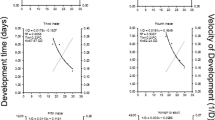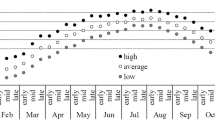Abstract
The current study was conducted to evaluate the effects of constant temperature (16, 24 and 32 °C) on the biology of Callosobruchus chinensis L. (Coleoptera: Bruchidae). The study revealed that all the biological parameters C. chinensis were affected by the three temperatures tested. The results showed that the duration of egg, larval, pupal and adult longevity were decreased as the temperature increased. The longest duration needed for the insect to complete its life cycle was 76.8 days at 16 °C. Increasing temperature from 16 to 32 °C reduced the period duration needed for the insect to complete its life cycle to 24.7 days at 32 °C. The most favorable temperature for the development of egg, larva and pupa of C. chinensis was 32 °C. The developmental thresholds were 10.62, 7.80, 10.23 and 8.98 °C and the corresponding thermal units were 83.57, 359.45, 137.40 and 579.52 day-degree for egg, larval, pupal and from egg to adult, respectively. Also, analysis of variance showed significant effect of temperature on the pre-oviposition, oviposition and post-oviposition periods. It was clear that survival period of the adult decreased considerably with the increase in temperature from 16 to 32 °C. Also, the data showed that the adult females lived longer than males at all tested temperatures.





Similar content being viewed by others
References
Adhikary P, Anandamay B (2012) Effect of temperature on biology of Callosobruchus maculatus (F.). Indian J Entomol 74:261–266
Ahmady A, Hazim Z, Rahmatzai N, Mousa MAA, Zaitoun AA (2017) Effect of temperature on the biology of flour beetle, Tribolium confusum Jacquelin du Val (Coleoptera: Tenebrionidae) in the laboratory. Int J Zool Stud 2(1):39–42
Alam MZ (1971) Pests of stored grain and other stored products and their control. Publ. Information service, 3, R.K.Mission road, Dhaka, Bangladesh. 361pp
Boshra S (1993) Some factors affecting the longevity, oviposition and rate of development of Callosobruchus chinensis Linn. During storage. Bull Entomol Soc Egypt 71:163–171
Fields PG (1992) The control of stored-product insects and mites with extreme temperatures. J Stored Prod Res 28:89–118
Flinn PW, Hagstrum DW (1990) Simultaneous comparing the effectiveness of various stored grain management practices and tocontrol Rhizopertha dominica. Environ Entomol 19:725–729
Ghosh SK, Durbey SL (2003) Integrated management of stored grain pests. International Book Distributing Co., Lucknow, India
Han ED, An JH (1990) Studies on ecology and control of the azuki bean weevil Callosobruchus chinensis (Linn.), in Korea. Res Rep Rural Dev Adm Crop Prot 32:24–59
Howe RW, Currie JE (1964) Some laboratory observations on the rates of development, mortality and oviposition of several species of Bruchidae breeding in stored pulses. Bull Entomol Res 55:437–477
Hulse JH (1991) Nature, composition and utilization of grain legumes, in: uses of tropical legumes: proceedings of a consultant meetings, 27-30 march 1989, ICRISAT Centre, Patancheru, A.P. 502324, India
IITA (1989) Research brief, 9: International Institute of Tropical Agriculture, Ibadam, Nigeria
Jaiswal DK, Raju SVS, Kumar D, Vani VM (2018) Studies on biology of pulse beetle, Callosobruchus chinensis (L.) on stored chickpea under laboratory conditions. J Pharmacog Phytochem 7(6):464–467
Katsuki M, Miyatake T (2009) Effects of temperature on mating duration, sperm transfer and remating frequency in Callosobruchus chinensis. J Insect Physiol 55:113–116
Koura A, El-Halfawy MA, Bishara SD (1972) On the biology of Tenebrio molitor (Linn.) in Egypt (Coleoptera: Tenebrionidae). Bull Soc Entomol Egypt 56:297–300
Lale NE, Vidal S (2003) Effect of constant temperature and humidity on oviposition and development of Callosobruchus maculatus (F.) and Callosobruchus subinnotatus (pic) on bambara groundnut, Vigna subterranea (L.) Verdcourt. J Stored Prod Res 39(5):459–470
Loganathan M, Jayas DS, Fields PG, White NDG (2011) Low and high temperatures for the control of cowpea beetle, Callosobruchus maculatus (F.) (Coleoptera: Bruchidae) in chickpeas. J Stored Prod Res 47:244–248
Madubunyi LC, Koehler CS (1974) Effect of photoperiod and temperature in Hypera brunneipennis. Environ Entomol 3:1017–1021
Maharjan R, Ahn JJ, Park CG, Yoon YN, Jang Y, Kang HW, Bae SD (2017) Effects of temperature on the development of the azuki bean weevil, Callosobruchus chinensis (Coleoptera: Bruchidae) on two leguminous seeds. J Stored Prod Res 72:90–99
Mahmoud MA (2012) Ecobiological studies on granary weevil, Sitophilus granarius L. infesting wheat crop in Upper Egypt. M.Sc. Thesis, Fac Agric Assiut Univ Egypt, 174pp
Mahroof R, Subramanyam B, Eustace D (2003) Temperature and relative humidity profiles during heat treatment of mills and its efficacy against Tribolium castaneum (Herbst) life stages. J Stored Prod Res 39:555–569
Mai El-Degwi MS (1983) Ecological and biological studies on the granary weevil, Sitophilus granarius L. (Coleoptera: Curculionidae). M.Sc. Thesis, Fac Agric Cairo Univ Egypt, 186pp
Mansoor-ul-Hasan A, Aslam A, Jafir M, Javed MW, Shehzad M, Chaudhary MZ, Aftab M (2017) Effect of temperature and relative humidity on development of Sitophilus oryzae L. (Coleoptera: Curculionidae). J Entomol Zool Stud 5(6):85–90
Neven LG (2000) Insect physiological responses to heat. Postharvest Biol Technol 21:103–111
Omar YMM (1999) Biological and ecological studies on certain pests infesting stored products and their control in upper Egypt. M.Sc. Thesis, Fac Agric Assiut Univ Egypt, 117pp
Osman MAM, Mahmoud MF, Mohamed KM (2015) Susceptibility of certain pulse grains to Callosobruchus maculatus (f.) (Bruchidae: Coleoptera), and influence of temperature on its biological attributes. J Appl Plant Prot Suez Canal Univ Egypt 3:9–15
Pandey NK, Singh SC (1997) Observation on the biology of pulse beetle, Callosobruchus chinensis (Linn.) infested stored pulses. Uttar Pradesh J Zool 17:38–42
Raina AK (1970) Callosobruchus spp. infesting stored pulses (grain legumes) in India and comparative study of their biology. Indian J Entomol 32(4):303–310
Raja M, John WS, Jayakumar M (2007) Repellent activity of plant extracts against pulse beetle Callosobruchus maculatus (fab.) (Coleoptera: Bruchidae). Hexapoda 14:142–145
Riaz T, Shakoori FR, Ali SS (2014) Effect of temperature on the development, survival, fecundity and longevity of stored grain pest, Trogoderma granarium. Pakistan J Zool 46(6):1485–1489
Roesli R, Subramanyam B, Fairchild F, Behnke K (2003) Trap catches of stored product insects before and after heat treatment of a pilot feed mill. J Stored Prod Res 39:521–540
Saleh RYA (1990) Comparative study on the biology and morphology of two different grain weevil strains: Sitophilus granarius granarius L. and Sitophilus granarius africanus Zach. (Curculionidae, Coleoptera). Ph.D. Thesis, Fac Agric Cairo Univ Egypt, 193pp
Shaheen FA (2014) Critical temperature change as important factor of Callosobruchus chinensis L. management in chickpea grains. Asian J Agric Biol 2(4):258–262
Sharma S, Thakur DR (2014) Biochemical basis of bruchid resistance in cowpea, chickpea and soybean genotypes. Am J Food Technol 9:318–324
Sharma M, Pareek BL, Sharma KP (2007) Studies on the biology of pulse beetle, Callosobruchus maculatus (F.) (Coleoptera: bruchidae). Soybean Res 5:38–42
Subramanyam B, Hagstrum DW (1995) Integrated management of insects in stored products. Marcel Dekker Inc, New York, pp 331–398
Verma S, Malik M, Kumar P, Choudhary D, Jaiwal PK, Jaiwal R (2018) Susceptibility of four Indian grain legumes to three species of stored pest, bruchid (Callosobruchus) and effect of temperature on bruchids. Int J Entomol Res 3(2):5–10
Vishwanatha KP, Saifulla M, Chandrashekara K, Mudalagiriyapp A, Nagaraju K, Nehru SD (2011) Chickpea research in Karnataka, present status and future prospects. AICRP on Chickpea, UAS, GKVK, Bangalore
Watanabe N (1991) Adzuki bean weevil and cowpea weevil. In: Yushima K, Kumano S, Tamaki Y (eds) Rearing methods of insects. Nihon-shyokubutuboueki-kyokai, Tokyo, pp 270–274
Yusof O, Ho SH (1992) A survey of insecticidal resistance in Sitophilus zeamais Motsch. in Malaysia and Singapore. J Plant Prot Tropics 9:219–225
Funding
The current study hasn’t any fund from any organizations or institutions, consequently we want this manuscript to be published in closed access.
Author information
Authors and Affiliations
Corresponding author
Ethics declarations
Conflict of interest
The authors declare that they have no competing interests.
Additional information
Publisher’s note
Springer Nature remains neutral with regard to jurisdictional claims in published maps and institutional affiliations.
Rights and permissions
About this article
Cite this article
Omar, Y.M., Mahmoud, M. Effects of three constant temperature ranges to control Callosobruchus chinensis (Coleoptera: Bruchidae): a serious pest of pulses in Egypt. Int J Trop Insect Sci 40, 1013–1020 (2020). https://doi.org/10.1007/s42690-020-00159-y
Received:
Accepted:
Published:
Issue Date:
DOI: https://doi.org/10.1007/s42690-020-00159-y




